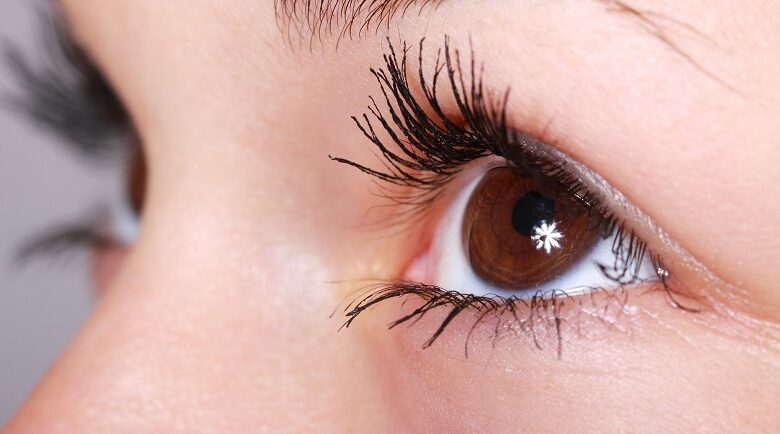
Living with acute retinal necrosis: what it means for me
Our writer and news editor, Emma Purcell, shares her blog post on how her visual impairment, caused by acute retinal necrosis, affects her. With little information available online, she hopes her detailed account of what it means for her and what the world really looks like through her eyes will help others with the same condition.
15 years ago, my life changed forever when I became registered blind. A virus attacked my retinas, which caused retina detachments. This then led me to be diagnosed with the eye condition acute retinal necrosis.
Over the years, I’ve noticed there is not very much information on acute retinal necrosis and I’ve never really come across anyone with the same eye condition.
Therefore, I think with this personal milestone approaching and wanting to raise awareness about this condition, I thought I would try to share my understanding and experience of living with acute retinal necrosis.
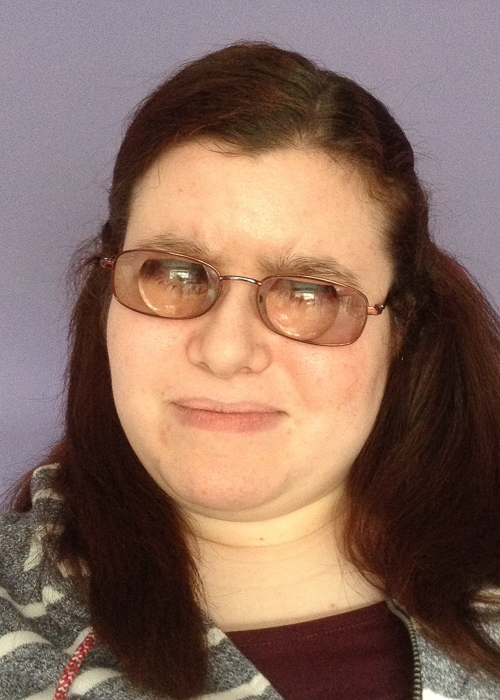
What is acute retinal necrosis?
I only discovered the exact name of my eye condition about six years ago when I was signing up to a care agency and they needed to know my disability and health conditions.
I was curious to know what it was called. I managed to find the name of my eye condition on a letter from my eye consultant and discovered it was called acute retinal necrosis (ARN).
Once I found it, my initial thought was to research it online. The most obvious places to start looking were the NHS and RNIB websites. However, I could not find any information on ARN.
Although, I did find a piece on the RNIB website about retinal detachments, which occurs in people who have ARN.
After some more digging online, I found a page that gives a simplistic yet detailed description of Acute Retinal Necrosis. According to EyeWiki:
“Acute retinal necrosis (ARN) is an inflammatory condition which may present as panuveitis. The principal causative viral agents have been found to be Varicella Zoster Virus (VZV) as well as Herpes Simplex Virus (HSV-1 and HSV-2) via polymerase chain reaction (PCR) testing of intraocular fluid.”
Looking at my medical records, I have “Bilateral ARN secondary to HSV”. The EyeWiki article states that:
“Older patients more often present with VZV or HSV-1 infections while younger patients more often present with HSV-2 infections.”
Therefore, I’m educationally guessing I had the HSV-2 virus.
Despite ARN being caused by a viral infection, it is not said to be contagious. In some cases, it’s believed to be a genetic condition. Even my consultant suspected mine to be a result of my genes, but we never found proof.
Symptoms of ARN, which I’ve experienced, include redness, photophobia, pain, floaters, and flashes.
Sadly, there is currently no cure for ARN and it’s just a case of maintaining the remaining vision.
The beginning of my sight loss journey
Before I share the story of how my sight loss journey began, I need to make you aware that I was only a child when this all happened. My memory and understanding of it is, therefore, all is very vague and some of the information may not be accurate.
I am actually going to take you back to 18 years ago in 2002 when I was just 8 years old. At the time, I was recovering from hip surgery when my right eye became very red and uncomfortable (I have cerebral palsy and am also a wheelchair user).
My GP visited me at home and said I should go to the eye emergency department immediately at Queen Alexandra Hospital in Portsmouth. My mum took me and after a few tests, I was diagnosed with a virus in my retina. I then had to go for additional tests in London at St. Thomas’s Hospital and Great Ormond Street Hospital.
However, the severity of the virus caused my retina to detach, which meant I became blind with only light perception remaining in my right eye.
For the next three years, I managed to cope being blind in one eye and continued at mainstream school and enjoyed all the same activities as before.
Then, in September 2005, two weeks into starting secondary school, my life changed forever. I woke up one morning feeling discomfort in my left eye. I immediately went to the eye emergency department and the doctors suspected the same virus.
I was sent to St. Thomas’s Hospital in London to get a biopsy done to confirm the diagnosis. I then spent two weeks in hospital being given some kind of medication through an IV drip. I think it was something to stop the virus causing more damage to my eye.
On the plus side, I enjoyed many walks along the River Thames with my parents and I made an appearance on the television programme City Hospital, where I was interviewed by Ainsley Harriott.
I was discharged from hospital in mid October 2005 and was officially classed as registered blind with the condition Acute Retinal Necrosis.
Adapting to my sight loss
The events that unfolded between the end of 2005 to 2010 are quite blurred (excuse the pun).
For the first six months to a year, I had to use my manual wheelchair and be pushed around because my eyesight was too poor to be able to drive my electric wheelchair independently. I also had to stop attending my drama classes at Helen O’Grady Drama Academy for about a year.
I was given my first pair of glasses in 2006 in the hope that it would improve my vision.
Although my glasses do make some difference, I am still unable to see a lot and still rely on a lot of adaptations and technology, such as magnification and voice-over to carry out tasks (see below).
My time at mainstream school became very difficult, in which I was bullied, felt very lonely and isolated and the teachers could not accommodate my additional needs.
Therefore, in 2008, I moved to Treloar school in Alton, which provides specialist education and care for children and young adults with disabilities.
As you may already know from previous blog content, I heavily rely on assistive technology and adaptations to do my work and carry out tasks. Plus, I’m campaigning for audio description on all films and TV shows.
You can check out all these blog posts here:
- Assistive tech tips
- 10 accessibility features on MacBook Air
- 5 reasons audio description is important to people with sight loss
- Top assistive technology and apps for people with sight loss
- Accessibility features on TV streaming services for blind and visually impaired people
My operations – oil bubble and chelations
In 2007, I had an operation on my left eye to have an oil bubble (I think medically known as silicone oil tamponade), inserted in my eye in order to hold my retina and to prevent it detaching.
Although this does stop me losing more sight and going totally blind, it can cause more blurred vision and discomfort due to a calcium buildup on the surface of the eye. It’s basically like a foggy, cloudy blob in the centre of my eye.
As a result, on a yearly to bi-yearly basis, I have to have a procedure to remove the calcium buildup. This procedure is called a chelation.
The first few times I actually had laser eye surgery, similar to the procedures people have to get corrected vision. I had the first two at St. Thomas’s Hospital, but then the laser machine was no longer available at this hospital so I was transferred to Moorfields Eye Hospital.
After the third laser treatment in around 2009/2010, I was no longer able to have this because there was not enough cornea remaining after the previous laser treatments.
Since then, I’ve had to have a manual chelation, which involves the surgeon using a small implement to manually scrape off the calcium buildup on my eye. I have had this procedure done on five or six occasions now, with the most recent one being last month.
They literally clamp my eye open, put in anaesthetic drops and begin scraping. On some occasions I have been given sedation to make me more comfortable.
Following the surgery, I am unable to open my eye for about a week and I can be in a lot of discomfort and pain throughout my recovery.
I have been told by the consultant that I can only have this procedure a number of times before there is no cornea in my left eye. At the moment, I’m not sure if and when I will stop these procedures and what the next stages will be in maintaining the vision I have remaining.
My vision
Right eye
In my right eye, I can see if a light is on or off and the movement of something, but I wouldn’t be able to say the size, shape or colour of the moving object/body part.
Left eye
In my left eye, without my glasses, things appear as if I’m looking through tracing paper. Everything is literally just blobs.
I can make out bold, bright colours (e.g red, yellow, green, blue) but I can’t make the difference between all shades (e.g blue or green, red or orange, red or pink, blue or purple etc).
With my glasses, I can see the first letter on an eye test letter chart. At distance, everything still looks like tracing paper and close up text between font size 10 to 28 looks like dots/wiggly lines.

On a screen, I need the text size 36 to 72 with colour invert turned on and/or zoom on 80% to 100%. Most images are hard to focus, even with zoom on. I can see if it’s a human, animal or object but can’t always identify exactly who or what it is.
When outside, on sunny days, all I can see is sunlight beams glaring my vision and preventing me seeing anything at all. I cannot identify step-curbs and drop-down curbs unless it has tactile paving.
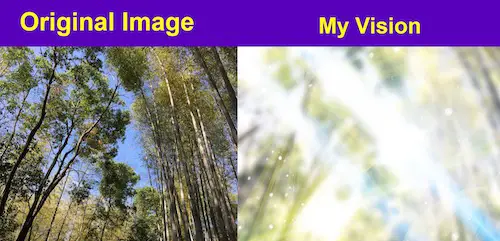
At night, everything is pitch black and when streetlights, car headlights or traffic lights are on they glare my vision like the sunlight.
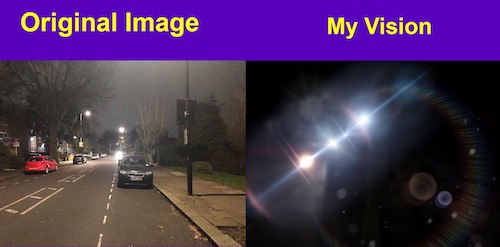
In addition, I get these multicolour floaters that almost look like kaleidoscope patterns. On occasions, I have these bright flashes that evolve into what looks like a semi-circle disco ball then dissolve with 30 seconds.
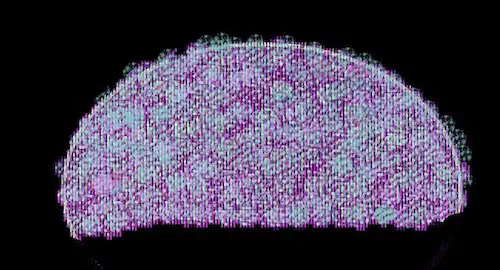
Moreover, on the top of my eye, I can see this partial red blob that almost looks like a blood puddle or a sea creature from the film Finding Nemo.
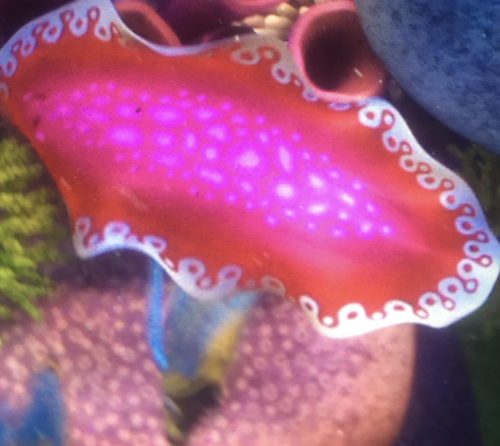
I have no idea why I get these floaters, flashes and blobs but I’m so used to them, they don’t bother me much anymore.
Living with acute retinal necrosis
I hope this blog post has given you a better insight and understanding of my eye condition.
Overall, acute retinal necrosis is a frustrating, complex and rare eye condition. In all honesty, there is still so much of it I don’t understand, nor does my consultants. I would love to learn more about acute retinal necrosis – how it occurred and alternative treatment options.
Plus, I’d like to meet other people also living with acute retinal necrosis so that we can discuss what it’s like living with this eye condition and support each other through what can be tough at times.
If you or someone you know has acute retinal necrosis or is a medical professional specialising in this eye condition, please do get in touch with me.
By Emma Purcell
Find out more about Emma and get in touch with her by visiting her blog, Rock For Disability, Facebook, Twitter @P94Emma, Pinterest or use the contact form on her blog.
More on Disability Horizons…